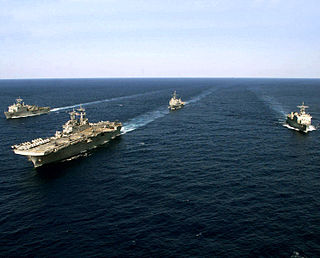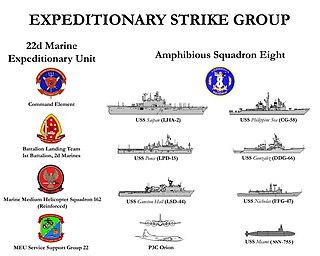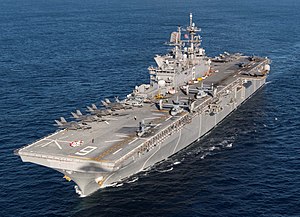
An aircraft carrier is a warship that serves as a seagoing airbase, equipped with a full-length flight deck and facilities for carrying, arming, deploying, and recovering aircraft. Typically, it is the capital ship of a fleet, as it allows a naval force to project air power worldwide without depending on local bases for staging aircraft operations. Carriers have evolved since their inception in the early twentieth century from wooden vessels used to deploy balloons to nuclear-powered warships that carry numerous fighters, strike aircraft, helicopters, and other types of aircraft. While heavier aircraft such as fixed-wing gunships and bombers have been launched from aircraft carriers, these aircraft have not landed on a carrier. By its diplomatic and tactical power, its mobility, its autonomy and the variety of its means, the aircraft carrier is often the centerpiece of modern combat fleets. Tactically or even strategically, it replaced the battleship in the role of flagship of a fleet. One of its great advantages is that, by sailing in international waters, it does not interfere with any territorial sovereignty and thus obviates the need for overflight authorizations from third-party countries, reduces the times and transit distances of aircraft and therefore significantly increases the time of availability on the combat zone.

The Tarawa class is a ship class of Landing Helicopter Assault (LHA) type amphibious assault ships operated by the United States Navy (USN). Five ships were built by Ingalls Shipbuilding between 1971 and 1980; another four ships were planned, but later canceled; instead they were joined by the Wasp-class amphibious assault ships.

The Wasp-class is a class of landing helicopter dock (LHD) amphibious assault ships operated by the United States Navy. Based on the Tarawa class, with modifications to operate more advanced aircraft and landing craft, the Wasp-class is capable of transporting almost the full strength of a United States Marine Corps Marine Expeditionary Unit (MEU), and landing them in hostile territory via landing craft or helicopters as well as providing air support via AV-8B Harrier II attack aircraft or F-35B Lightning II stealth strike-fighters. All Wasp-class ships were built by Ingalls Shipbuilding, at Pascagoula, Mississippi, with the lead ship, USS Wasp, commissioned on 29 July 1989. Eight Wasp-class ships were built, and as of April 2021, seven are in active service, as USS Bonhomme Richard was seriously damaged by fire on 12 July 2020, and subsequently decommissioned in April 2021.

Ingalls Shipbuilding is a shipyard located in Pascagoula, Mississippi, United States, originally established in 1938, and now part of HII. It is a leading producer of ships for the United States Navy, and, as of 2023, is the largest private employer in Mississippi.

The San Antonio class is a class of amphibious transport docks, also called a "landing platform, dock" (LPD), used by the United States Navy. These warships replace the Austin-class LPDs, as well as the Newport-class tank landing ships, the Anchorage-class dock landing ships, and the Charleston-class amphibious cargo ships that have already been retired.

USS Wasp (LHD-1) is a United States Navy multipurpose amphibious assault ship, and the lead ship of her class. She is the tenth USN vessel to bear the name since 1775, with the last two ships named Wasp being aircraft carriers. She was built by the Ingalls Shipbuilding division of Litton in Pascagoula, Mississippi. Wasp and her sister ships are the first specifically designed to accommodate new Landing Craft Air Cushion (LCAC) for fast troop movement over the beach, and Harrier II (AV-8B) Vertical/Short Take-Off and Landing (V/STOL) jets which provide close air support for the assault force. She can also accommodate the full range of Navy and Marine Corps helicopters, the tiltrotor MV-22 Osprey, the F-35B Lightning II multi-role fighter, conventional landing craft, and amphibious vehicles.

A landing helicopter dock (LHD) is a multipurpose amphibious assault ship that is capable of operating as a helicopter carrier and also has a well deck for supporting landing crafts. LHD vessels are built with a full flight deck similar in appearance to a light aircraft carrier to operate VTOL rotorcrafts such as utility and attack helicopters, and can also support tiltrotor aircraft and VSTOL fixed-wing aircraft. Some future designs might even support CATOBAR operations for light aircraft and UCAVs via aircraft catapults and arresting gears.

Landing helicopter assault (LHA) is the United States Navy's hull classification symbol for the general-purpose helicopter-carrying amphibious assault ships of the Tarawa and America classes.

An amphibious ready group (ARG) of the United States Navy consists of a naval element—a group of warships known as an Amphibious Task Force (ATF)—and a landing force (LF) of U.S. Marines, in total about 5,000 people. Together, these elements and supporting units are trained, organized, and equipped to perform amphibious operations.

In the United States Navy, the expeditionary strike group (ESG) is a coordinated group of surface ships, aircraft, submarines, and other naval assets. In contrast to carrier strike groups (CSGs), which emphasize air power and are led by a supercarrier, ESGs are strongly suited for amphibious warfare and are led by an amphibious assault ship. The ESG concept was introduced in the early 1990s, based on the Naval Expeditionary Task Force. The U.S. Navy fields nine expeditionary strike groups.

USS America (LHA-6), is an amphibious assault ship of the United States Navy and the lead ship of the America-class amphibious assault ship. The fourth U.S. warship to be named for the United States of America, she was delivered in spring of 2014, replacing Peleliu of the Tarawa class. Her mission is to act as the flagship of an expeditionary strike group or amphibious ready group, carrying part of a Marine expeditionary unit into battle and putting them ashore with helicopters and V-22 Osprey tilt-rotor aircraft, supported by F-35B Lightning II aircraft and helicopter gunships.

An amphibious assault ship is a type of amphibious warfare ship employed to land and support ground forces on enemy territory during an amphibious assault. The design evolved from aircraft carriers converted for use as helicopter carriers. Modern designs support amphibious landing craft, with most designs including a well deck. Like the aircraft carriers they were developed from, some amphibious assault ships also support V/STOL fixed-wing aircraft and have a secondary role as aircraft carriers.

Huntington Ingalls Industries, Inc. (HII) is the largest military shipbuilding company in the United States as well as a provider of professional services to partners in government and industry. HII, ranked No. 375 on the Fortune 500, was formed on 31 March 2011, as a divestiture from Northrop Grumman.

USS Tripoli (LHA-7) is the second America-class amphibious assault ship built for the United States Navy. On 7 May 2012, United States Secretary of the Navy Ray Mabus announced the ship's name as Tripoli, in honor of the US Marine Corps victory against Tripoli at the Battle of Derna during the First Barbary War. This is the third US Naval ship to carry the name, the first being USS Tripoli (CVE-64), an escort carrier from World War II and the second being USS Tripoli (LPH-10), an amphibious assault ship that served during the Cold War.

USS Bougainville (LHA-8) is an America-class amphibious assault ship currently under construction for the United States Navy. She will be the second Navy ship to be named Bougainville.
The LX(R) class is a class of amphibious warfare ships under development for the United States Navy, to be contracted from 2020, as a replacement for the current Whidbey Island-class and Harpers Ferry-class dock landing ships.

USS Fallujah (LHA-9) will be an America-class amphibious assault ship of the United States Navy and the first ship to bear this name to commemorate the first and second battles at Fallujah during the Iraq War in 2004. On 13 December 2022, Secretary of the Navy Carlos Del Toro announced the name in a press release.

USS Helmand Province (LHA-10) will be the fifth America-class amphibious assault ship of the United States Navy. The ship is named after the Afghan Helmand Province, the site of a US Marine Corps campaign during the War in Afghanistan.


















